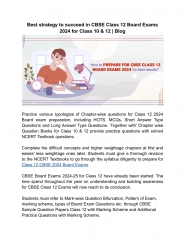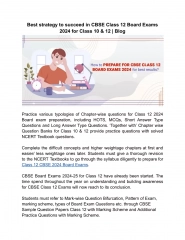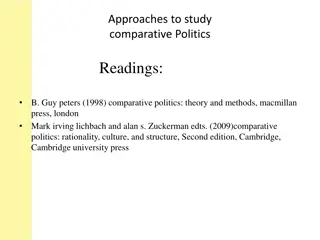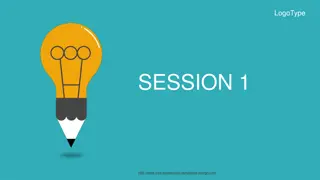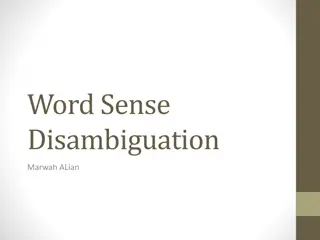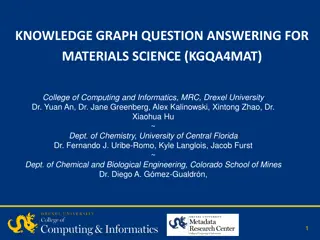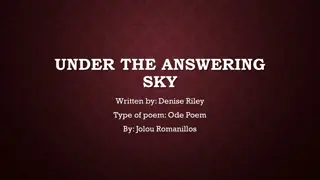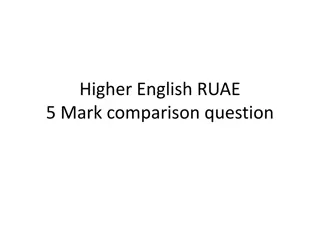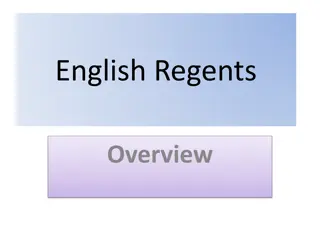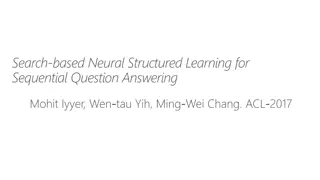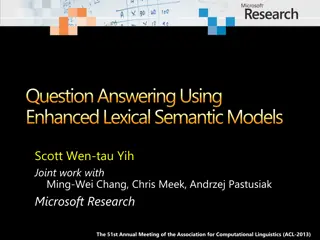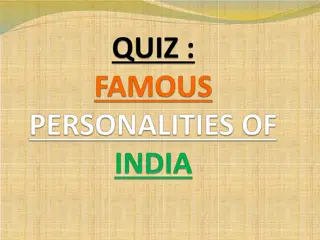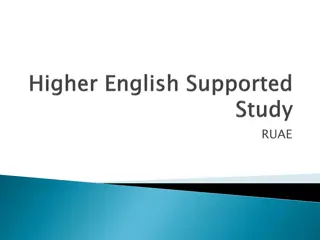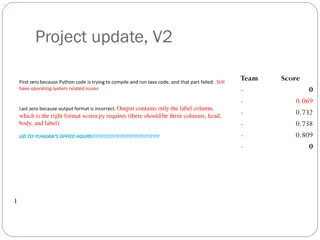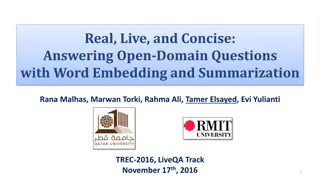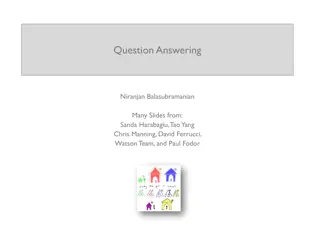Ensembling Diverse Approaches to Question Answering
Diverse types of question answering approaches include factoid querying, compositional querying of structured databases/knowledge graphs, reading comprehension, and visual question answering. Limitations of factoid question answering are also discussed, highlighting the need for specific queries and inability to aggregate information. The importance of learning semantic parsers for knowledge base question answering is emphasized, along with recent structured query datasets. Additionally, traditional semantic parsing limitations are outlined, emphasizing the need for predetermined semantic ontology and database structures. The field of automated knowledge base construction is introduced, emphasizing the integration of document corpus, information extraction systems, and knowledge base question answering.
Download Presentation

Please find below an Image/Link to download the presentation.
The content on the website is provided AS IS for your information and personal use only. It may not be sold, licensed, or shared on other websites without obtaining consent from the author.If you encounter any issues during the download, it is possible that the publisher has removed the file from their server.
You are allowed to download the files provided on this website for personal or commercial use, subject to the condition that they are used lawfully. All files are the property of their respective owners.
The content on the website is provided AS IS for your information and personal use only. It may not be sold, licensed, or shared on other websites without obtaining consent from the author.
E N D
Presentation Transcript
Ensembling Diverse Approaches to Question Answering Raymond J. Mooney Dept. of Computer Science University of Texas at Austin 1
Diverse Types of Q/A Factoid querying of open-domain raw text. Compositional querying of manually curated structured database / knowledge-graph. Compositional querying of knowledge base/graph automatically constructed from raw text. Reading comprehension querying of specific documents. Visual question answering from images and/or videos. 2
Open Domain Factoid Q/A Document corpus Answer String Q/A System Question NIST TREC Q/A track initiated in 1998. Which museum in Florence was damaged by a major bomb explosion in 1993? Combine IR passage retrieval with limited NLP processing (NER, SRL, Question Classification). 3
Limitations of Factoid Q/A Question must query a specific fact that is explicitly stated somewhere in the document corpus. Does not allow aggregating or accumulating information across multiple information sources. Does not require deep compositional semantics, nor inferential reasoning to generate answer. 4
Learning Semantic Parsers for KB Q/A Semantic parsers can be automatically learned from various forms of supervision: Questions + logical forms Questions + answers (latent logical form) 5
Recent Structured Query Datasets Freebase queries (limited compositionality) Free917 (Cai & Yates, 2013) How many works did Mozart dedicate to Joseph Haydn? WebQuestions (Berant et al., 2013) What music did Beethoven compose? Wikipedia table questions (more compositionality, must generalize to new test tables) WikiTableQuestions (Pasupat & Liang, 2015) How many runners took 2 minutes at the most to run 1500 meters? 6
Limitations of Traditional Semantic Parsing Requires fixed, predetermined semantic ontology of types and relations. Requires pre-assembled database or knowledge base/graph. Not easily generalized to open-domain Q/A 7
Q/A for AKBC (Automated Knowledge Base Construction) Document corpus IE System KB Question Answer String Q/A System 8
Issues with AKBC Q/A KB may contain uncertainty and errors due to imperfect extraction. Can create ontology automatically using Unsupervised Semantic Parsing (USP) Use relational clustering of words and phrases to automatically induce a latent set of semantic predicates for types and relations from dependency-parsed text (Poon & Domingos, 2008; Titov & Klementiev, 2011; Lewis & Steedman, 2013). 9
Reading Comprehension Q/A Answer questions that test comprehension of a specific document. Use standardized tests of reading comprehension to evaluate performance (Hirschman et al. 1999; Rilo & Thelen, 2000; Ng et al. 2000; Charniak et al. 2000). 10
Large Scale Reading Comprehension Data DeepMind s large-scale data for reading comprehension Q/A (Hermann et al., 2015). News articles used as source documents. Questions constructed automatically from article summary sentences. 12
Sample DeepMind Reading Comprehension Test 13
Deep LSTM Reader DeepMind uses LSTM recurrent neural net (RNN) to encode document and query into a vector that is then used to predict the answer. Document LSTM Encoder Answer Extractor Embedding Answer Question Incorporated various forms of attention to focus the reader on answering the question while reading the document. 14
Visual Question Answering (VQA) Answer natural language questions about information in images. VaTech/MSR group has put together VQA dataset with ~750K questions over ~250K images (Antol et al., 2016). 15
VQA Examples 16
Hybrid RNN/Semantic-Parsing for Q/A Recent approach composes neural-network for a specific question (Andreas et al. 2016). Combines syntactic parse with lexically- based component neural networks. Test on multiple types of Q/A Visual Question Answering Geographical database queries 18
Compositional Neural Nets for Q/A (Andreas et al., 2016) 19
Ensembling for Q/A Ensembling multiple methods is a proven approach to generating robust, general- purpose systems. Using supervised learning to train a meta- classifier to optimally combine multiple outputs, i.e. stacking (Wolpert, 1992), is particularly effective. 20
Stacking in IBM Watson Stacking was used to combine evidence for each answer from many different components in the IBM Watson Jeopardy system (Ferrucci et al. 2010) . Meta-classifier was trained to correctly answer years of prior Jeopardy questions. 21
Stacking with Auxiliary Features for KBP Slot Filling For each proposed slot-fill, e.g. spouse(Barack, Michelle), combine multiple system confidences and additional features conf 1 System 1 Provenance Features Slot Type conf 2 System 2 SVM MetaClassifier System N-1 conf N-1 Accept? conf N System N (Rajani & Mooney, ACL 2015) 22
Ensembling Systems With and Without Prior Performance Data Stacking restricts us to ensembling systems for which we have training data from previous years. Use unsupervised ensembling to first combine confidence scores for new systems. Employ constrained optimization approach of Weng et al. (2013) . Then use stacking to combine result of the resulting unsupervised ensemble with supervised systems. 23
Combining Supervised and Unsupervised Methods using Stacking conf 1 Sup System 1 Provenance Features Slot Type conf 2 Sup System 2 Sup System N conf N SVM MetaClassifier Unsup System 1 Calibrated conf Unsup System 2 Accept? Unsup System M Constrained Optimization (Weng et al., 2013) 24
New Auxiliary Provenance Features Query Document Similarity Features KBP SF queries come with a query document to disambiguate the query entity. For each system, compute cosine similarity between its provenance document and the query document. Provenance Document Similarity Features For each system, compute the average cosine similarity between its provenance document and the provenance document of all other systems. 25
KBP 2015 Cold Start Slot Filling Ensembling Track Results Approach Precision Recall F1 Combined supervised and unsupervised with new features 0.4314 0.4489 0.4679 Combined supervised and unsupervised without new features 0.4789 0.3588 0.4103 Only supervised stacking approach (ACL 2015) 0.5084 0.2855 0.3657 Top ranked CSSF 2015 system 0.3989 0.3058 0.3462 Constrained optimization on all systems (Weng et al., 2013) 0.1712 0.3998 0.2397 26
Stacking for General Q/A A promising approach to building a general Q/A system is to stack a variety of the approaches we have reviewed Possibly using auxiliary provenance features. 27
Conclusions There are many diverse types of question- answering scenarios. There are many diverse approaches to each of these Q/A scenarios. Ensembling these diverse approaches is a promising approach to building a general purpose Q/A system. 28



